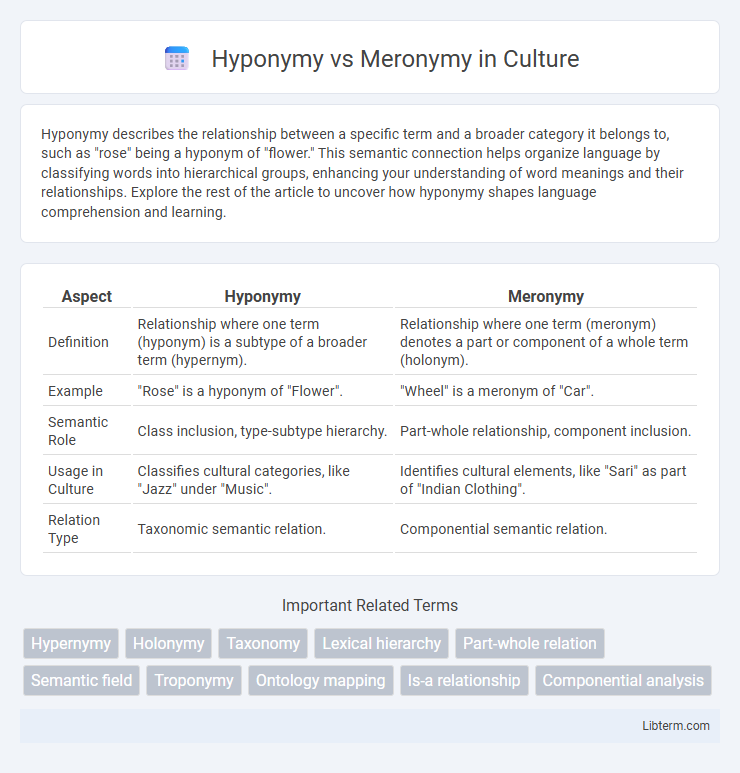Hyponymy describes the relationship between a specific term and a broader category it belongs to, such as "rose" being a hyponym of "flower." This semantic connection helps organize language by classifying words into hierarchical groups, enhancing your understanding of word meanings and their relationships. Explore the rest of the article to uncover how hyponymy shapes language comprehension and learning.
Table of Comparison
| Aspect | Hyponymy | Meronymy |
|---|---|---|
| Definition | Relationship where one term (hyponym) is a subtype of a broader term (hypernym). | Relationship where one term (meronym) denotes a part or component of a whole term (holonym). |
| Example | "Rose" is a hyponym of "Flower". | "Wheel" is a meronym of "Car". |
| Semantic Role | Class inclusion, type-subtype hierarchy. | Part-whole relationship, component inclusion. |
| Usage in Culture | Classifies cultural categories, like "Jazz" under "Music". | Identifies cultural elements, like "Sari" as part of "Indian Clothing". |
| Relation Type | Taxonomic semantic relation. | Componential semantic relation. |
Introduction to Hyponymy and Meronymy
Hyponymy refers to the semantic relationship where a word's meaning is included within the meaning of a more general term, exemplified by "rose" as a hyponym of "flower." Meronymy describes the part-whole relationship between terms, such as "wheel" being a meronym of "car." Both relationships are essential in lexical semantics for understanding hierarchical and componential structures in language.
Defining Hyponymy: Meaning and Examples
Hyponymy defines a semantic relationship where a word's meaning is included within another broader term, known as the hypernym; for example, "rose" is a hyponym of "flower," meaning every rose is a type of flower. This hierarchical relationship helps categorize vocabulary by specific-to-general connections, enhancing lexical organization in natural language processing and ontology design. Unlike meronymy, which represents part-whole relationships, hyponymy emphasizes subclass inclusion to structure word meanings efficiently.
Understanding Meronymy: Meaning and Examples
Meronymy describes the semantic relationship where one term denotes a part of something else, such as "wheel" being a meronym of "car." This part-whole connection differs from hyponymy, which involves a type-of relationship like "rose" as a hyponym of "flower." Understanding meronymy involves recognizing how components relate to their wholes, exemplified by terms like "finger" to "hand" or "engine" to "car.
Key Differences Between Hyponymy and Meronymy
Hyponymy describes a hierarchical relationship where one term (the hyponym) is a specific instance of a broader category (the hypernym), such as "rose" being a hyponym of "flower." Meronymy refers to a part-whole relationship where a term denotes a component of a larger whole, for example, "wheel" as a meronym of "car." The key difference lies in hyponymy's category-instance connection versus meronymy's part-to-whole structure, essential for semantic analysis and language processing.
The Role of Hyponymy in Language Semantics
Hyponymy plays a crucial role in language semantics by establishing hierarchical relationships between general and specific terms, such as "flower" (hypernym) and "rose" (hyponym), enabling precise meaning differentiation and categorization. This relationship supports effective lexical organization and semantic search, enhancing natural language processing tasks like information retrieval and word sense disambiguation. Understanding hyponymy allows linguists and AI systems to model semantic hierarchies that contribute to more nuanced language comprehension.
The Impact of Meronymy on Conceptual Understanding
Meronymy, the relationship between a part and its whole, enhances conceptual understanding by allowing individuals to break down complex categories into smaller, manageable components. Unlike hyponymy, which arranges concepts hierarchically from general to specific, meronymy provides insight into the internal structure and composition of entities, facilitating finer-grained categorization and knowledge representation. This part-whole perspective is crucial in fields like linguistics, cognitive science, and artificial intelligence for improving semantic precision and reasoning processes.
Linguistic Applications of Hyponymy
Hyponymy, a semantic relation where a term denotes a subclass of a broader category, plays a crucial role in natural language processing tasks such as ontology building and semantic search optimization. It enables precise concept hierarchy modeling by establishing "is-a" relationships, which improve information retrieval systems and lexical databases like WordNet. Unlike meronymy, which denotes part-whole relationships, hyponymy facilitates hypernym identification, essential for automatic text classification and semantic entailment.
Real-world Uses of Meronymy in Communication
Meronymy, the semantic relationship where one term denotes a part of something else, plays a crucial role in real-world communication by enabling precise descriptions and efficient information exchange. In fields like medicine, automotive repair, and design, using meronyms such as "engine" for a car or "leaf" for a tree enhances clarity and specificity in instructions and discussions. This part-whole relationship aids in organizing knowledge, improving comprehension, and facilitating technical and everyday conversations.
Common Challenges in Distinguishing Hyponymy and Meronymy
Distinguishing hyponymy from meronymy often poses challenges due to the inherent overlap in part-whole and class-subclass relationships, where terms like "wheel" (part of a car) and "sedan" (type of car) can be confused. Ambiguity arises when words represent both subsets and components depending on context, complicating automatic semantic parsing in natural language processing. Accurate identification requires nuanced understanding of semantic roles and hierarchical structures within lexical databases such as WordNet.
Conclusion: Importance in Semantic Analysis
Hyponymy and meronymy are fundamental semantic relations crucial for natural language understanding and ontology development. Hyponymy captures hierarchical category membership, enabling precise classification and retrieval of information, while meronymy details part-whole relationships essential for comprehensive entity representation. Together, these relations enhance semantic analysis by improving lexical inference, knowledge representation, and contextual interpretation in linguistic and AI applications.
Hyponymy Infographic

 libterm.com
libterm.com